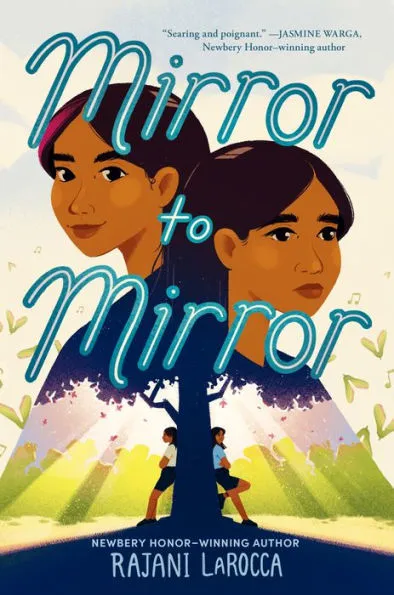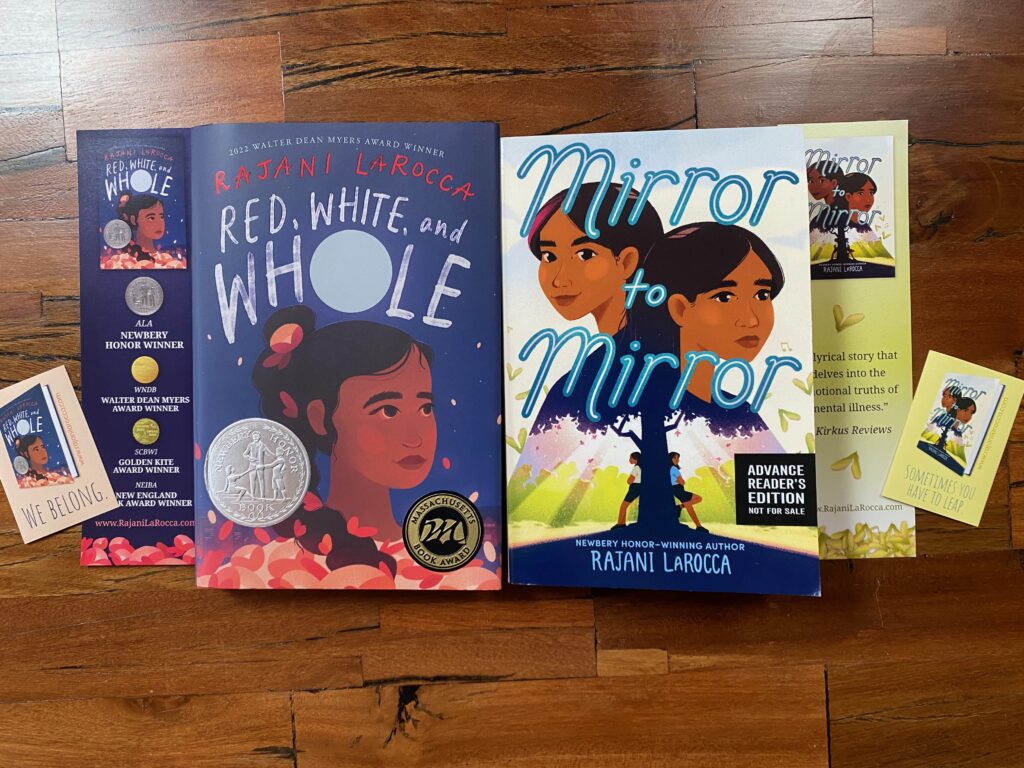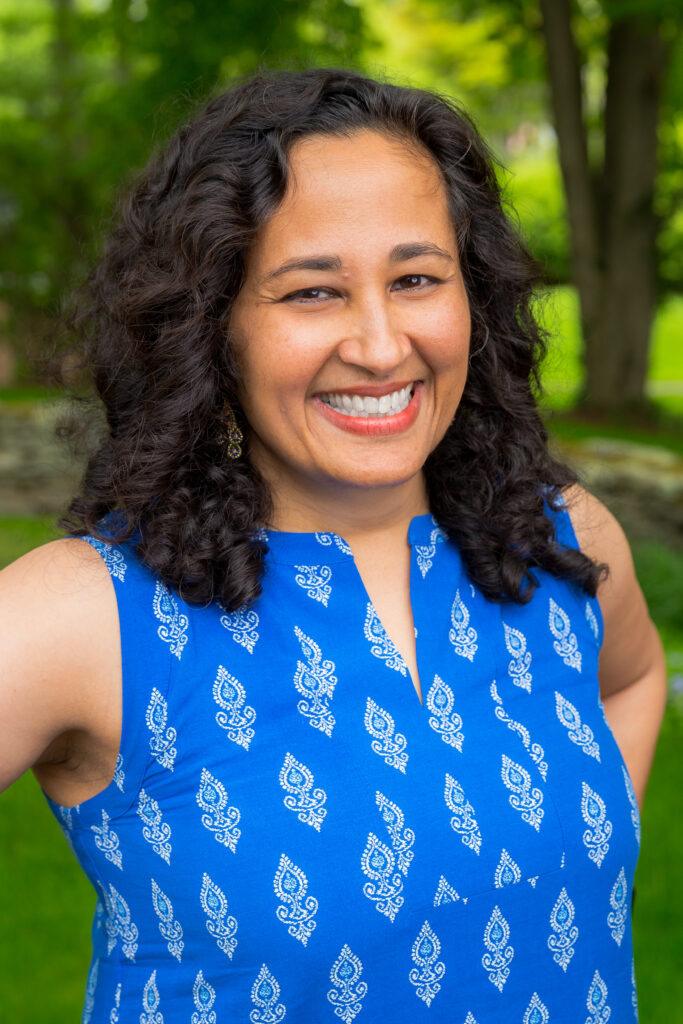Love, Family, and Mental Health, a guest post by Rajani LaRocca

Mirror to Mirror is my new middle grade novel in verse, releasing today. This story started with a single poem: a ghazal, a poetic form that is popular and South Asia and the Middle East and is often set to music. I wrote a poem about a girl lamenting that her twin has changed, that they are no longer as close as they used to be.

That started me asking questions about why this happened and who these sisters were.
I wrote Mirror to Mirror in 2020-2021, when the COVID-19 pandemic changed the entire world. People suffered with separation, isolation, illness, and death. And alongside that infectious pandemic was another pandemic, of anxiety and depression. This is true for people I treat as a primary care doctor; it is true for friends and family members; and it is true for me. It was not easy to write this book, which I did while my family was grappling with some serious challenges. Although the story is full of love and music, summer camp and sisterhood, it also deals with challenging mental health topics, which were hard to delve into given what was going on in my own life at the time.
ADVERTISEMENT
ADVERTISEMENT
Maya and Chaya, the identical twin main characters in Mirror to Mirror, are as close as two people can possibly be—soulmates who love music almost as much as they love each other. Maya thinks of her sister as “the one/who sees without showing/knows without telling/loves without asking.” And Chaya thinks of Maya as “the one I look up to, the one I come home to/the best part of me/in a separate space.”
But Maya is struggling. Most of the time, she feels anxious, guilty, and scared, feelings that started when she made a “mistake” as a small child that left her feeling responsible for all the bad things that happen to her family. Maya describes her anxiety in this way:
Cold silence descends,
numbing ice that spreads,
and the world blurs.
Maya doesn’t feel she can share how she’s feeling with those she loves. Her mother also has mental health issues that she’s not facing, and, despite loving her children, says she wants them to be “perfect,” inadvertently reinforcing Maya’s perfectionist streak. Her parents are arguing, and Maya is terrified that she could break her family apart if she reveals her struggles.
Chaya wants to help her twin. She can’t understand where her anxiety is coming from, or why Maya is so different from her. Chaya learns in science class that as identical twins grow, their genetics diverge. And she thinks:
So, science supports what I already know:
that Maya and I, who started the same,
grow more different with every breath.
I want to return to that time
when we were the same
to that time
before her sadness began.
Chaya knows how to distract Maya, how to get her to focus on something else when panic threatens to paralyze her. But Maya’s anxiety is getting worse, and Chaya knows she needs more help than she can give. When Chaya tries to tell their parents, Maya stops her, and then shuts her out completely.
Chaya searches for the source of Maya’s panic and thinks it might have something to do with her—after all, she looks identical to her sister, and plays the same classical music. So Chaya decides to change the only thing she can: herself. She transforms the way she looks as well as the type of music she plays—swapping classical piano for popular songs and musical theater—so that Maya no longer feels like she’s competing with her. Through new activities and different friends, Chaya grows happier. But Maya does not.
The third part of the story is set at the twins’ music summer camp, where they make a bet to switch places, pretending to be each other and playing each other’s music. Whoever lasts the longest without being discovered gets to choose where they both go to high school—something they’ve been arguing about. Through masquerading as each other and fooling family and friends, by literally walking in each other’s shoes, the twins learn important things about each other, and about themselves.

One of the notions I explore in this story is how love by itself may not be enough to overcome mental health challenges. Chaya loves Maya more than anything, but even she doesn’t have a complete understanding of what Maya is going through, and her love cannot dispel Maya’s anxiety, no matter how much she wants it to. The twins’ parents love their children and have money and resources, but they cannot see how their daughter is suffering, and the mother refuses to face her own mental health challenges.
I also consider the intersection of culture and mental health. In my experience as an immigrant and a physician, many immigrants are reluctant to admit to mental health concerns since they are worried that any perceived “weakness” may be exploited to their disadvantage.
Ultimately, after facing her worst fear and getting through it, Maya is able to tell her family about her struggles with anxiety. And despite Maya’s worries over how her parents might react, they express their love and support, and most importantly, they say that they will make sure she gets help from a professional. Maya conveys how it feels to finally unburden herself:
. . . it’s like
breathing clean air,
like hearing music for the first time
again.
I hope this story helps young readers recognize that anxiety and depression are not weaknesses or flaws, but a part of life—and something that can be treated. Through reading about Maya and Chaya’s journey, I hope readers understand that they should share their struggles with those they trust and love, because it’s only through revealing how we feel and admitting we need help that we can start to get it.
Meet the author

ADVERTISEMENT
ADVERTISEMENT
Rajani LaRocca was born in India, raised in Kentucky, and now lives in the Boston area, where she practices medicine and writes award-winning books for young readers, including the Newbery Honor-winning middle grade novel in verse, Red, White, and Whole. She’s always been an omnivorous reader, and now she is an omnivorous writer of fiction and nonfiction, novels and picture books, prose and poetry. She finds inspiration in her family, her childhood, the natural world, math, science, and just about everywhere she looks. Learn more about Rajani and her books at www.RajaniLaRocca.com. She also co-hosts the STEM Women in KidLit Podcast.
Website: https://www.rajanilarocca.com/
Twitter: https://twitter.com/rajanilarocca
Instagram: https://www.instagram.com/rajanilarocca/
https://www.facebook.com/rajanilaroccawriter
About Mirror to Mirror
Rajani LaRocca, recipient of a Newbery Honor and Walter Award for Red, White, and Whole, is back with an evocative novel in verse about identical twin sisters who do everything together—until external pressures threaten to break them apart.
Maya is the pragmatic twin, but her secret anxiety threatens to overwhelm her.
Chaya is the outgoing twin. When she sees her beloved sister suffering, she wants to tell their parents—which makes Maya feel completely betrayed. With Maya shutting her out, Chaya makes a dramatic change to give her twin the space she seems to need. But that’s the last thing Maya wants, and the girls just drift further apart.
The once-close sisters can’t seem to find their rhythm, so they make a bet: they’ll switch places at their summer camp, and whoever can keep the ruse going longer will get to decide where they both attend high school—the source of frequent arguments. But stepping into each other’s shoes comes with its own difficulties, and the girls don’t know how they’re going to make it.
This emotional, lyrical story will speak to fans of Ali Benjamin, Padma Venkatraman, and Jasmine Warga.
ISBN-13: 9780063047471
Publisher: HarperCollins Publishers
Publication date: 03/21/2023
Age Range: 8 – 12 Years
Filed under: Guest Post
About Amanda MacGregor
Amanda MacGregor works in an elementary library, loves dogs, and can be found on Twitter @CiteSomething.
ADVERTISEMENT
ADVERTISEMENT
SLJ Blog Network
The 2024 Ninja Report: Bleak
A Sequel Coming This Summer That You Won’t Want to Miss: Bob Shea Discusses His Latest
Review| Agents of S.U.I.T. 2
ADVERTISEMENT







